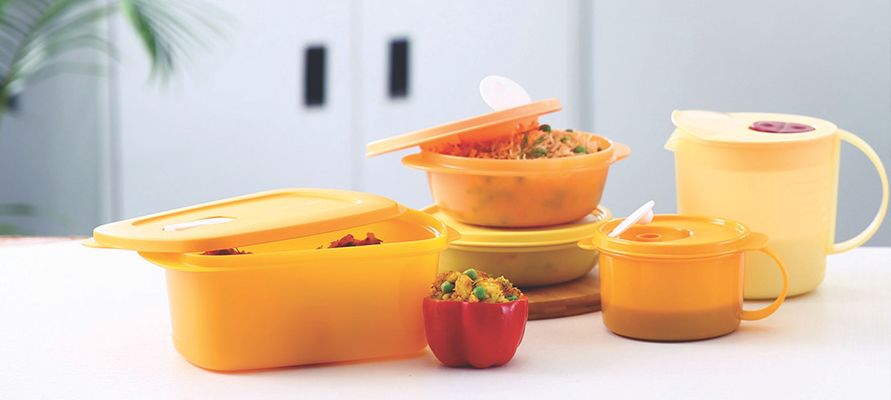Every morning I would get up and pack myself multiple boxes of food in colorful, multi-sized containers for work. During lunchtime, I would heat the food in those colorful containers and eat from them. Not to forget, almost everyone in the queue at my office in India would be carrying food in similar plastic containers with “Tupperware” engraved on them.
Tupperware, a brand symbolizing a homely and wholesome way of living, is a household name in food storage in the world.
To know what has made Tupperware a household phenomenon, let us know its history.
Earl Tupper, a chemical Engineer, created Tupperware in the early 1940s. He came up with a durable, flexible, odorless, non-toxic plastic to make storage containers. A product that would keep food fresh, he patented the ingenious Tupper Seal in 1949. He introduced the range into mom and pop stores. Unfortunately, consumers did not understand how to use the Seal, and the product remained on shelves.
And if it weren’t for Brownie Wise, a divorced single mom with an eighth-grade education but expert sales skills, Tupperware wouldn’t have become a household name.
The intuitive marketing genius built an empire of Tupperware out of bowls that burped with an innovative sales and marketing strategy. She introduced the concept of “Home Party Sales,” and trained a small army of Tupperware Ladies to host them in their living rooms across America in the 1950s. She rewarded her sales force with gifts and modern appliances at extravagant annual jubilees which the company filmed. Her saleswomen earned thousands, even millions, selling Tupperware.
And the experience changed their lives. Direct selling became such a big hit that it made the brand eventually stop retail sales entirely and work only on direct-selling system.
Tupperware business model and its tryst with Indian household
Tupperware debuted in India in 1996 and immediately came face to face with very traditional – and often inflexible – kitchen habits. Until then depending upon the economic strength of the family, cooking and storage were done in tin, aluminium, glass, steel or copper containers. The company stormed this glass and metal bastion by presenting a range of high-quality, lightweight, rust- and break-proof, colourful, airtight, stylish products which kept food fresh longer, thus avoiding waste.
Its entry strategy to India was simple, i.e. the direct sales technique. It helped Tupperware with keeping the prices in check by taking away the middle-man. It also created a social network of consumers who could influence purchases in the comfort of their homes.
Tupperware’s entry came as an opportunity for many women who were looking to supplement the household income. Without any impediments associated with education or economic status, Indian women found themselves with a degree of self-belief, respect and financial freedom.
Tupperware India has about 50,000 active consultants who sell its products – the largest women’s sales force in the country, making it one of the biggest direct-selling brands in the country.
How did Tupperware maintain its foothold in India amidst rising competition offering cheaper products?
Tupperware’s major competition came from Retail stores offering cheaper products. The brand supplemented the “Tupperware parties” route with alternate media to aid word of mouth generated by their agents and connect consumers to Tupperware Salesforce rapidly.
They continued offering a value-for-money product, backed by a lifetime warranty which worked well for consumers. Consumers who bought Tupperware saw the value and continued to choose the brand despite the premium price.
The brand is already riding the online wave and has opened outlets in key cities. However, its significant business still comes from age-old “Tupperware parties.”
Decoding the Marketing Strategy & mix of Tupperware in India
Product:
Tupperware entered the Indian market with the anticipation to be a formidable market force in the kitchenware segment. The brand comes with a range of kitchenware products used for cooking, serving, and storage. It brought a revolution that changed the Indian consumer behavior from one that depended on traditional metal food containers to one that is plastic-based.

Price:
While Tupperware products might be priced marginally high compared to other plastic containers in the market, the value-for-money that consumers get makes them consider these products cheap. In addition, the proposition of providing a lifetime warranty backed by solid quality works well with the customers.

Placement:
The company employs a sort of franchise model where business leaders are created in every town and city. These leaders appoint sales forces, train them and send them to execute the company’s agenda. Globally, the companies’ significant sales come from the emerging market where there is a rise in increasing spending power.

Promotion:
Tupperware uses the Direct Selling business model in India and is one of the biggest brands in terms of revenue. It recruits women as their sales force, who typically take all the buying decisions in the family when it comes to the kitchen. The “Tupperware Parties” business model has worked well for the brand since inception and still works as a proven model. Alongside, the brand also provides food preparation tips and advice to consumers using Tupperware products.
Tupperware’s story is not about a brand selling kitchenware. It is a brand that has empowered women to unfold their true potential, look at life differently and become financially independent. Sold in more than 100 countries, the brands continue to offer diverse, beautiful and convenient products. Tupperware, as a brand has created a place in our kitchen as well as our heart.
Leaving you all with some food for thought!!
Interested in reading more Marketing Strategy Stories? Check out our collection.
-AMAZONPOLLY-ONLYWORDS-START-
Also, check out our most loved stories below

Why did Michelin, a tire company, decide to rate restaurants?
Is ‘Michelin Star’ by the same Michelin that sells tires, yes, it is! But Why? How a tire company evaluations became most coveted in the culinary industry?

Bajaj Auto: The Story of an Indian Born Global Brand
Bajaj Auto has evolved tremendously over time from its traditional scooter Chetak to having the trendiest bike Pulsar. It has managed to stay relevant.

Jio’s Offensive Marketing Warfare: From Challenger to Leader
In just 4 years Reliance Jio has become the Indian telecom market leader due to its marketing warfare strategies. What is this strategy and how Jio used it?

Johnnie Walker – The legend that keeps walking!
Johnnie Walker is a 200 years old brand but it is still going strong with its marketing strategies and bold attitude to challenge the conventional norms.

Flipsters: Creating the Butterfly effect in Indian Startup Ecosystem
How is it that ex-Flipkart employees or Flipsters as they call themselves have achieved such massive success in the Indian Startup Ecosystem?

Nike doesn’t sell shoes. It sells an idea!!
Nike has built one of the most powerful brands in the world through its benefit based marketing strategy. What is this strategy and how Nike has used it?

Domino’s is not a pizza delivery company. What is it then?
How one step towards digital transformation completely changed the brand perception of Domino’s from a pizza delivery company to a technology company?

Why Indians love Old Monk? What is the revival plan of the dying brand?
Indians especially armed forces and college students for generations have loved Old Monk. What makes this rum so special? It’s classy, dark yet affordable.

IKEA- The new master of Glocalization in India?
IKEA is a global giant. But for India, the brand modified its business strategies. The adaptation strategy by a global brand is called Glocalization
-AMAZONPOLLY-ONLYWORDS-END-

















